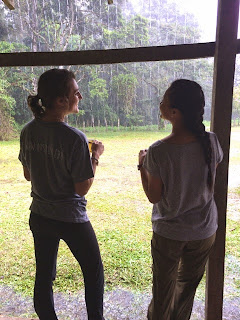One bitter morning in Las Alturas, I shiver out from under my three layers of blankets and try to get ready for the day. I brave the frosty air as I change into more presentable clothes—a rare occurrence among us OTS students. So what could have occasioned a change from yoga pants to jeans? A day at the local primary care EBAIS clinic. In Costa Rica, the healthcare system is socialized and there are multiple layers of the healthcare system. Because the system has been decentralized, the majority of healthcare takes place at these local EBAIS clinics that are staffed with one doctor, one nurse, one secretary, and an ATAP, whose job entails community health outreach. On this particular day, a group of eight students, including myself, went to the EBAIS clinic in Las Alturas to help provide healthcare. There were four pairs of partners and we rotated tasks: entertaining children in the outside waiting area, taking vitals, filling out intake forms and organizing patient files, and shadowing the physician in consultation.
During my favorite part of the morning, I colored with the kids and took requests on animals to draw, receiving ample support and compliments from them despite my very poor artistic abilities. Then, my partner and I rotated to the nurse's station, where we took weight, height, and calculated each patient's body mass index (BMI). Our next shift was in consultation with the doctor.
As one of few students who aren't pre-med on this program, I was not particularly interested in consultation. Therefore, I do not believe I went into the consultation room with the right mentality. However, I was further put off by the dynamic of the consultations. The doctor was excited to speak English and therefore continually explained everything to us in English. However, he did not explain the same things in Spanish to the patients, which made me quite uncomfortable. From my low expectations and my further frustration with the language dynamic, I left consultation after my first shift there with a sour taste in my mouth.
During my fourth and final shift at the EBAIS clinic, I was drawn back into consultation because the pair that was supposed to be shadowing were taking their coffee break. The doctor needed my help because he had a patient with a one week old infant and needed to examine both the mother and her daughter. He took wonderful care of them, conducting the baby's wellness checkup and then checking the mother's post-caesarean sutures while I looked on and held the baby. I shadowed one or two other consultations, and began to reconsider my prior notions on how the doctor treated his patients. I thought back on the first round of consultations I witnessed, and how he was kind to his patients. While he had many patients to see and very little time with which to see them all, he still took time to make them feel special. He would sweet talk the little girls, "Hola, mi amor, cómo estás mi corazoncito?" and ask the little boys about school. None of his patients seemed to be phased by him speaking to us in English; only my partner and I were uncomfortable by it.
The morning I spent in consultation at the EBAIS clinic left me with many thoughts. First, I wondered at whether my first judgment of the doctor and consultations were a manner of me applying my own morals on a situation where they did not apply. If so, was it right of me to be bothered by the situation if those directly involved were not? Second, I thought about the importance of a doctor building a rapport with his/her patients; when I saw the doctor interacting with his patients, I could tell how relaxed and comfortable they felt with him. I realize now how important that is in a proper health intervention, even at the local clinical level. While I certainly still have no intentions of becoming a doctor, I am happy to have learned this lesson and hope to be able to carry it on with me in my work in the public/global health field.
EBAIS in Las Alturas, Costa Rica. Photo Credits: Allison Draper







